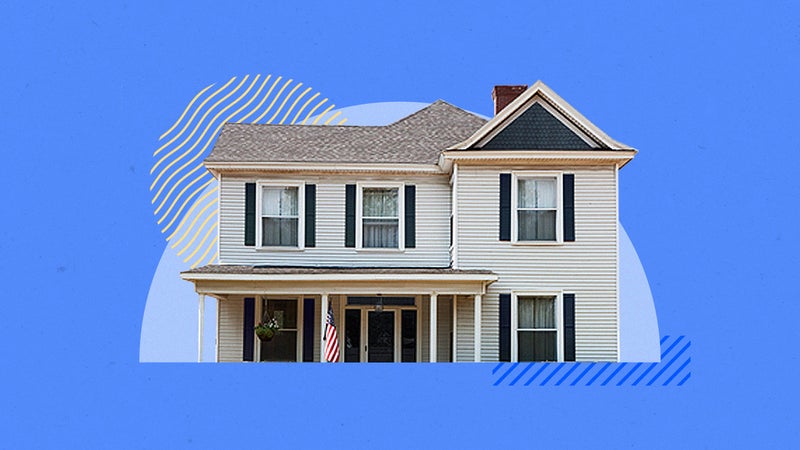How to get a mortgage

The Bankrate promise
At Bankrate we strive to help you make smarter financial decisions. While we adhere to strict , this post may contain references to products from our partners. Here's an explanation for .
Key takeaways
- To prepare for getting a mortgage, be sure to know what you can realistically afford, how much you'll have saved for a down payment and if you need to improve your credit score before applying.
- Comparing offers from multiple lenders — at least three — could save you a significant amount of money.
- Along with your down payment, you'll need to pay closing costs, which typically cost 2 to 5 percent of the loan principal but vary by state.
For most Americans, taking out a mortgage makes buying a home possible. But how do you get a mortgage? This guide breaks down the mortgage process so you’ll know what to expect when you apply for a home loan.
How to get a mortgage
Step 1: Strengthen your credit
The best loan offers go to borrowers with credit scores in the 700s. That’s because a strong score demonstrates you can responsibly manage your debt.
“Having a strong credit history and credit score is important because it means you can qualify for favorable rates and terms when applying for a loan,” says Rod Griffin, senior director of Public Education and Advocacy for Experian, one of the three major credit reporting agencies.
If your credit score is on the lower side, you could still get a loan, but you’ll likely pay a higher interest rate.
To improve your credit before applying for your mortgage, Griffin recommends these tips:
- Make all payments on time and reduce your credit card balances: Your payment history on your report goes back two years or longer, so start now if you can.
- Bring any past-due accounts current: Past-due accounts will sink your score. Bringing all of these accounts current and continuing to pay them on time can limit some of the damage.
- Review your credit reports: You can check your credit reports weekly for free at AnnualCreditReport.com. Check for errors on your credit reports, and contact the reporting bureau immediately if you spot any. For example, an error might be a paid-off loan that hasn’t been recorded as such, or an incorrect address.
- Check your credit score: Check your reports and score well before applying for a mortgage. When you review your score, you’ll see a list of the top factors impacting it, which can tell you what changes to make to get your credit in shape, if needed.
Step 2: Know what you can afford
One way to determine how much house you can afford is to figure out your debt-to-income (DTI) ratio. The DTI ratio is calculated by summing up all of your monthly debt payments and dividing that figure by your gross monthly income.
The lower your DTI ratio, the more room you’ll have in your budget for expenses not related to your home. That’s why Andrea Woroch, a Bakersfield, California-based personal finance and budgeting authority, says it’s essential to take into account all your monthly expenses and your set-asides for far-off plans.
“The last thing you want to do is get locked into a mortgage payment that limits your lifestyle flexibility and keeps you from accomplishing your goals,” says Woroch— a condition known as “house poor.”
You can determine how much house you can afford by using Bankrate’s calculator, which factors in your income, monthly obligations, estimated down payment and other details of your mortgage.
Step 3: Build your savings
Your first savings goal should be enough for a sufficient down payment.
However, know that you can still buy a home, even if you do not have a 20 percent down payment saved. For example, conventional mortgages require a minimum of 3 percent down, FHA loans require 3.5 percent down and VA and USDA loans have no down payment requirements.
It’s equally important to build up your cash reserves. One rule of thumb is to have the equivalent of roughly six months’ worth of mortgage payments in a savings account, even after you fork over the down payment. This cushion can help safeguard you if you lose your job or something else unexpected happens.
Don’t forget to factor in closing costs, which are the fees you’ll pay to finalize the mortgage. These typically run between 2 to 5 percent of the loan’s principal. They don’t include escrow payments, either, which are a separate expense. Generally, you’ll also need around 1 to 4 percent of the home’s price for annual maintenance and repair costs.
Step 4: Compare mortgage rates and loan types
Once your credit score and savings are in a good place, start searching for the right kind of mortgage for your situation. The main types of mortgages include:
- Conventional loans: Conventional loans are loans that aren’t guaranteed or insured by the government. You’ll need at least a 620 credit score and a down payment of 3 to 5 percent to qualify.
- FHA loans: FHA loans, insured by the Federal Housing Agency (FHA), have more flexible financial requirements than conventional loans. They require a 3.5 percent down payment, a credit score of at least 580 and a DTI ratio not exceeding 43 percent.
- VA loans: VA loans are guaranteed by the U.S. Department of Veterans Affairs (VA), and are available for qualifying military members. They have no down payment requirement, and credit score requirements vary by lender.
- USDA loans: USDA loans, guaranteed by the U.S. Department of Agriculture (USDA), are available for properties in designated rural areas. They have no down payment requirement, and credit score requirements vary by lender.
- Jumbo loans: Jumbo loans are conventional loans for properties whose price tags exceed the federal threshold set for conforming loans ($766,550 in most parts of the country or $1,149,825 in more expensive areas). These loans often come with higher minimum credit score and down payment requirements.
Look at the interest rates and fees for each loan, which collectively amount to its annual percentage rate (APR). Even a small difference in interest rates can result in big savings over the long run. Also, consider things like whether you’ll have to pay for mortgage insurance, and for how long.
Mortgages are also differentiated by their rates and term lengths:
- Term length: Most home loans have 15- or 30-year terms, although there are 10-year, 20-year, 25-year and even 40-year mortgages available.
- Fixed-rate mortgage: A fixed-rate mortgage has the same interest rate throughout the length of the loan, so every payment will be the same. This predictability makes fixed-rate mortgages the most popular option, with the 30-year fixed-rate mortgage being the standard in the United States.
- Adjustable-rate mortgage: Adjustable-rate mortgages (ARMs) are 30-year mortgages that start with a lower, introductory interest rate. After their intro period, the rate adjusts based on a specified market index. You may see these loans referred to as 5/6 ARMs, 7/6 ARMs, 10/1 ARMs or another mix of numbers.
Step 5: Find a mortgage lender
Once you’ve decided on the type of mortgage, it’s time to find a mortgage lender.
“Speak with friends, family members and your agent and ask for referrals,” says Guy Silas, branch manager for the Rockville, Maryland office of Embrace Home Loans. “Also, look on rating sites, perform internet research and invest the time to truly read consumer reviews on lenders.”
“[Your] decision should be based on more than simply price and interest rate,” says Silas. “You will rely heavily on your lender for accurate preapproval information, assistance with your agent in contract negotiations and trusted advice.”
Reading lender reviews can help you learn about the pros and cons of various lenders and customer satisfaction, providing valuable context and helping you narrow the field.
If you’re not sure exactly what to look for, you might want help. A mortgage broker can help you navigate the different loan options available to you and possibly help you get more favorable terms than you’d be able to secure by applying yourself. Remember that interest rates, fees and terms can vary greatly from lender to lender. Bankrate can help you compare rates from different lenders.
Step 6: Get preapproved for a loan
Once you’ve settled on a lender, get preapproved for a mortgage. With preapproval, the lender will review your finances to determine if you’re eligible for funding and an amount they’re willing to lend you.
“Many sellers won’t entertain offers from someone who hasn’t already secured a preapproval,” says Griffin. “Getting preapproved is also important because you’ll know exactly how much money you’re approved to borrow.”
Be mindful that mortgage preapproval differs from prequalification. A preapproval involves much more documentation and a hard credit check. Mortgage prequalification is less formal and is essentially a way for a lender to tell you that you’d be a good applicant.
Still, preapproval doesn’t guarantee you’ll get the mortgage. That has to wait until you’ve made an offer on a house and successfully gone through mortgage underwriting.
Step 7: Begin house-hunting
With a preapproval in hand, you can begin seriously searching for a property that meets your needs. When you find a home with the perfect blend of affordability and livability, be ready to pounce.
“It’s essential to know what you’re looking for and what is feasible in your price range,” says Katsiaryna Bardos, finance department chair at Fairfield University in Fairfield, Connecticut. “Spend time examining the housing inventory, and be prepared to move quickly once the house that meets your criteria goes on the market.”
Step 8: Submit your loan application
If you’ve found a home you’re interested in purchasing, you’re ready to complete a mortgage application. These days, you can complete most applications online, but it can sometimes be more efficient to apply with a loan officer in person or over the phone. When you apply, your lender will perform a credit check and request documents from you, such as:
- Proof of identification: Including your driver’s license, Social Security card and/or other forms of government-issued ID
- Proof of income: Including paystubs, W-2s, 1099s, receipts of alimony and/or child support and rental income
- Proof of assets: Bank statements, investment and/or retirement account statements, bonds, stocks, etc.
- Gift letters: If a friend or relative gives you money for a down payment, you’ll need to submit a gift letter
Step 9: Wait out the underwriting process
Even though you’ve been preapproved for a loan, that doesn’t mean you’ll ultimately get financing from the lender. The final decision will come from the lender’s underwriting department, which evaluates the risk of each prospective borrower and the nature of the property, then determines the loan amount, interest rate and other terms.
Here are some steps involved in the underwriting process:
- A loan officer will confirm the information you provided during the application process.
- After you make an accepted offer on a home, the lender will order an appraisal of the property to determine whether the amount in your offer is appropriate. The appraised value depends on many factors, including the home’s condition and comparable properties, or “comps,” in the neighborhood.
- A title company will conduct a title search to ensure the property can be transferred, and a title insurer will issue an insurance policy that guarantees the accuracy of this research.
“After all your financial information is gathered, this information is submitted to an underwriter — a person or committee that makes credit determinations,” says Bruce Ailion, an Atlanta-based real estate attorney and Realtor. “That determination will either be yes, no or a request for more information from you.”
Step 10: Close on your new home
Once you’ve been officially approved for a mortgage, you’re nearing the finish line. All that’s needed at that point is to complete the closing.
“The closing process differs a bit from state to state,” says Ailion. “Mainly, it involves confirming the seller has ownership and is authorized to transfer title, determining if there are other claims against the property that must be paid off, collecting the money from the buyer and distributing it to the seller after deducting and paying other charges and fees.”
There are many expenses that accompany the closing. These typically include:
- Appraisal fee: Fee you pay to a professional appraiser to determine the value of the property you’re purchasing
- Credit check fee: Fee for running your credit report, usually less than $30
- Origination or underwriting fee: Fee that covers the cost of creating and processing your loan, usually 0.5 percent to 1 percent of the amount you’re borrowing
- Title insurance fees: Fees that cover title and settlement services, including for a lender’s insurance policy equal to 0.5 percent to 1 percent of the purchase price
- Prepaids: Expenses you’ll cover upfront, such as property taxes and homeowners insurance premiums
- Attorney fee: Usually a flat fee, though you may not be required to hire an attorney, as only 22 states require an attorney to be present at closing
- Recording fees: Flat fee to record the transaction with the proper local authority
Along with paying closing costs, you will review and sign lots of documentation at the closing, including details on how funds are disbursed. The closing or settlement agent will also enter the transaction into the public record.
What are mortgage lenders looking for?
Mortgage lenders are looking for creditworthy applicants with sufficient income, consistent repayment histories and manageable levels of debt. Ultimately, they want reassurance you’ll pay back the money you borrow.
The factors that go into a lender’s decision on whether or not to approve your mortgage application include:
- Credit score: Credit scores are based primarily on your credit history, pattern of repayment, credit utilization and credit mix. Depending on the type of mortgage, you might qualify even with a lower credit score. A higher score, though, gets you a better interest rate.
- Income and employment: To qualify for a mortgage, you’ll need to show evidence of a steady employment history and income high enough to afford the monthly payments.
- Low DTI ratio: Your DTI ratio is a measure of your monthly debt payments compared to your earnings. The lower your DTI ratio, the better. In general, a DTI ratio of 36 percent or less is ideal, though you might be able to qualify for a mortgage with a DTI ratio of up to 50 percent.
- Assets: Your lender will examine your bank accounts and the value of any other assets you hold. Though it’s not the norm, your lender might require you to have up to six months of mortgage payments in cash reserves, depending on the type of loan and your financial situation.
Mortgage process FAQ
-
The income required to get a mortgage depends on how much mortgage you need and how much debt you already have. Lenders like to see a DTI ratio of no more than 36 percent (up to 50 percent in some cases), so knowing this figure, along with your house budget, can help you determine whether your income would be sufficient. A loan officer can also help you do the math.
-
The minimum down payment ranges from 3 to 3.5 percent of the home’s purchase price for fixed-rate conventional loans and FHA loans, respectively. On a $400,000 home, for example, that range equals $12,000 to $14,000. If you qualify for a VA or USDA loan, you won’t need to make a down payment.
-
You’ll need to meet the eligibility criteria for the specific type of mortgage you’re getting. This includes parameters around credit score, debt and down payment. For an FHA loan, for example, you’ll need a credit score of at least 580 and a down payment of at least 3.5 percent.
-
You can get a mortgage through a direct or retail mortgage lender, such as a credit union, bank or online lender; through a mortgage broker; or another type of lender. Start shopping for a mortgage by comparing top offers on mortgage rates.
-
Don’t be shy when it comes to asking mortgage lenders questions as you shop around. Ask for help identifying what kind of mortgage loan may be the best fit for your situation. You may also wish to ask about any down-payment assistance programs you qualify for. While asking about interest rates can be beneficial, keep in mind some lenders will not disclose a rate until you’ve applied for a prequalification or preapproval.


